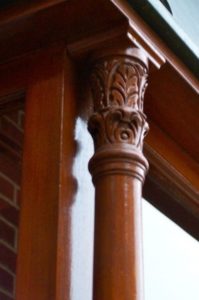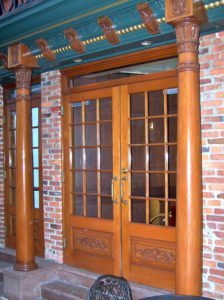African Mahogany
Khaya ivorensis

African Mahogany is the common name for a multitude of species variants, the two most common of which are Khaya ivorensis and Khaya senegalensis.
At J. Gibson McIlvain, we only stock a couple of these species, and we keep close track of which is which so we can supply consistency in color, grain, and workability to our customers. Regardless, we have cultivated relationships with mills in Africa to ensure we can supply the highest quality African Mahogany wood.
Although it shares a similar color with Genuine Mahogany (a somewhat lighter pink), its other characteristics are very different. African Mahogany is a pale reddish-brown color with a straight, interlocking grain, and the species is about 50% harder than most Mahogany woods.
This variegated grain can produce beautiful dark and light bands of color when finished. The range is vast with regions all over the African continent producing species variants that all get lumped under the trade name “African Mahogany.” This can cause confusion and concern when a single load of supposedly the same species is actually conglomerated from 3 or 4 species. In the end the customer can have a different experience from one board to the next.
We have worked hard with our African mills to isolate these species and buy unmixed containers of only the high quality species. The higher the quality of the African Mahogany, the better it will machine and finish, so our standards are very strict regarding the lumber we import.
AFRICAN MAHOGANY (KHAYA) SPECIFICATIONS
| Character | Green | Dry | Units |
| Bending Strength | 9500 | 13395 | psi |
| Crushing Strength | 4992 | 7680 | psi |
| Stiffness | 1412 | 1648 | 1000 psi |
| Work to Maximum Load | 10 | 12 | in-lbs/in3 |
| Hardness (Janka) | – | 1370 | lbs |
| Shearing Strength | – | 2209 | psi |
| Specific Gravity | 0.43 | 0.57 | – |
| Weight | 51 | 40 | lbs/ft3 |
| Density | – | 45 | lbs/ft3 |
| Radial Shrinkage | – | 4 | % |
| Tangential Shrinkage | – | 6 | % |

Like most Mahoganies, African Mahogany boasts a number of characteristics that make it especially well-suited to exterior applications, and it is often employed in door and window manufacturing projects. African Mahogany is the cheapest of the Mahoganies, and it is often purchased for use as an affordable alternative to Genuine Mahogany. Like Genuine Mahogany, African Mahogany is quite stable once finished; the species takes stain, clear coat, and paint very well, giving consumers plenty of flexibility.
At J. Gibson McIlvain, we work very hard to import only the finest African Mahogany, and with so many variables depending on growth region and species variations, this is no easy task. Nevertheless, we strive to maintain a large inventory of the world’s best selections of African Mahogany at all times.
– – – – – – – – – –
People frequently search for the following relevant terms: African Mahogany wood, is African Mahogany lumber sustainable, quarter sawn African Mahogany boards, price for African Mahogany timbers, janka rating for African Mahogany hardness.


